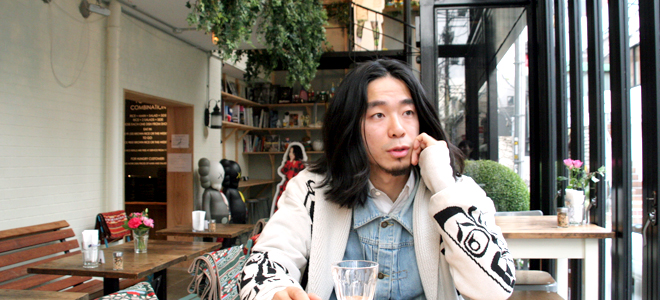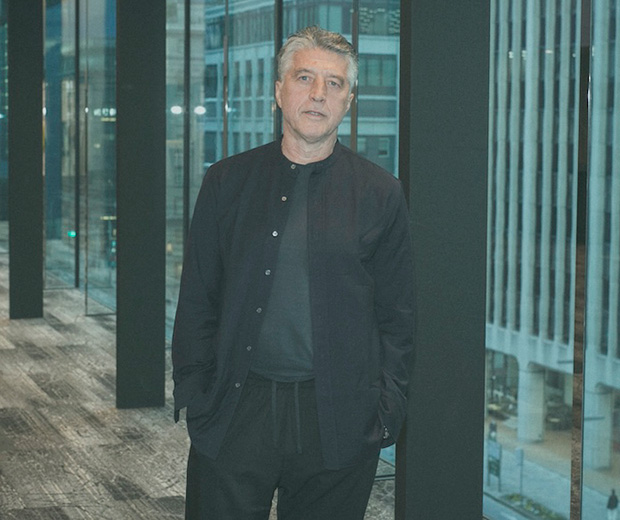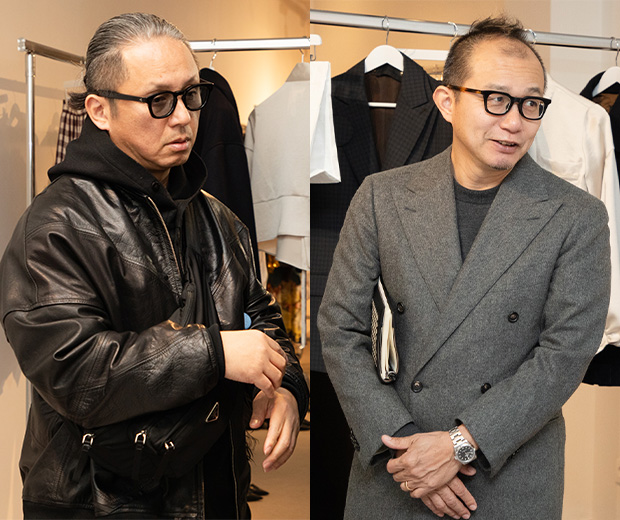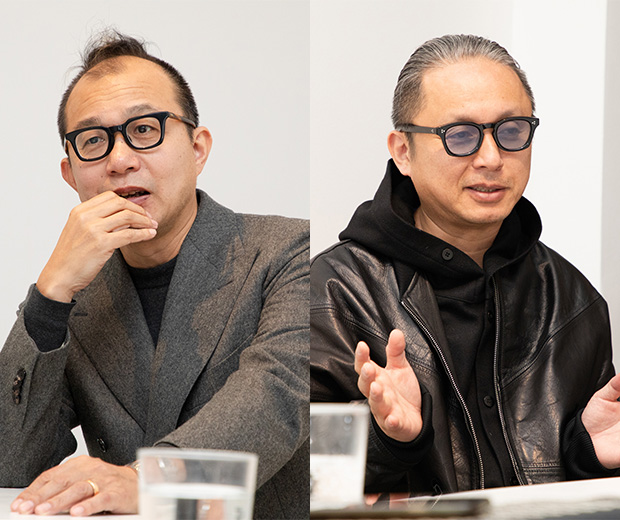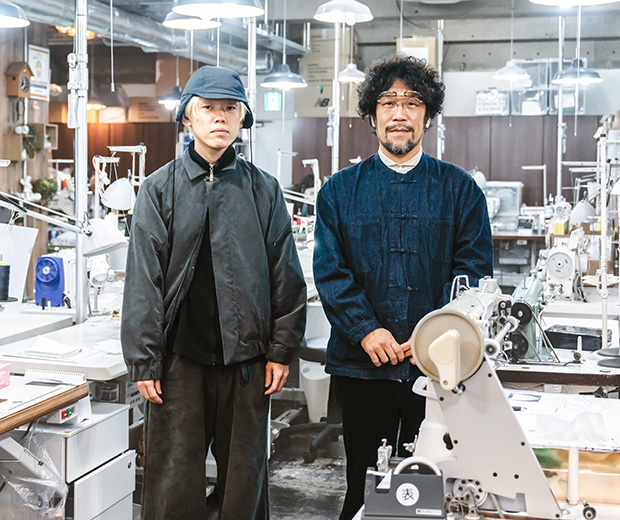HIROMICHI OCHIAI
The FACETASM brand has been growing steadily since its debut in 2007 and has become increasingly popular. The clothes made by the Tokyo-born-and-bred designer, Hiromichi Ochiai, exhibit a unique sensibility, perspective, and experiences, and portray the Tokyo of today in a very realistic manner.
With regards to the brand name “FACETASM,” Mr. Ochiai explains how we coined the term from the French word ‘facet’ which is defined as one of the flat polished surfaces of a gemstone such as a diamond, and using it to mean “various faces” and “various perspectives.” We asked Mr. Ochiai what he wants to express through FACETASM, how he perfects his craft, and what he thinks about fashion in Tokyo today.
You opened a limited shop at THE CONTEMPORARY FIX (TCF), a select shop in Aoyama, from March 18 to April 1. According to the owner, Yuichi Yoshii, this had been planned from last year, but because of the huge earthquake that occurred one week before the opening date, the reception party that was planned on the first day was cancelled. However, the limited shop itself was opened as planned to raise money for charity. How do you feel now that the limited shop period is over?
Ochiai: I think I was able to make this happen because of the strong support I received from everyone at TCF. During the limited shop period, the positive attitude of the staff and the heartfelt service that they provided to the customers helped me greatly. This was my third time holding a limited shop at TCF, but despite the fact that the number of customers that came on the first day was the lowest we’ve had so far, apparently our sales were up by 150% compared to the previous limited shop period. I was happy that my designer friends, such as Mr. Osumi of PHENOMENON, Mr. Yokoyama and Mr. Araki of SASQUATCHfabrix., and Mr. Ganryu of GANRYU, visited the store, and I felt that we were all united in our goal of “gathering here and helping out.” This year’s limited shop period was hastily turned into a charity event, in which 10% of proceeds (5% TCF, 5% FACETASM) were donated to the disaster-stricken areas, but I don’t feel that this was anything special; it was just the right thing to do. I’m sure that other brands would have done the same if they had also had events going on at the time of the disaster.
You had some interesting projects going on during the event, where you installed life-size photo panels of 25 models that you’d recruited from the general public in front of the store, and distributed reduced-size panels in the store. How did you decide upon this?
Ochiai: I’ve always been fortunate to be able to work with people I like for the Look photo shoots. The first shoot was supervised by Chikashi Suzuki, who works on the French magazine “Purple Fashion Magazine,” etc, and the second shoot was supervised by the stylist Michiko Kitamura. This project was produced by Mr. Yoshii of TCF, and was decided upon after consulting with all the staff members of TCF. Ryota Yamada was our stylist, Takae Kamikawa was our hair and makeup artist, and Naoki Ikehata was our photographer, and they dressed, made-up and photographed all 25 models in just one day. The method of presenting the models as panels was very innovative, and I feel that it was a good experience for me to move our brand forward.
The 25 models all differed in age, gender, and body shape – what criteria did you use in the selection process?
Ochiai: We selected the models along with the TCF staff members. We wanted to choose people with positive attitudes, and so we put a lot of emphasis on the comments that they provided, such as their application motive. I think that the people who were chosen were those that had a presence or some sort of unique quality, rather than people who looked like they would wear the brand well. In fact, we ended up with a group of people with strong individuality.
For this event, we did not make a large announcement, and we recruited models through media such as twitter, but we had ended up with over 70 applicants. Some of our actual models were from the quake-hit prefecture of Fukushima, who came all the way to TCF for the event. The first day of the event was just a few days after the earthquake, and there were many stores in Aoyama that were closed or shortened their business hours to save electricity. The area around TCF was dark, but only TCF was brightly lit up, and the sight of the panels of energetic models in the store was very uplifting.

The life-size panels of the models were lined up in front of THE CONTEMPORARY FIX during the limited shop period.


Inside the store were miniature versions of the panels…




Collaboration items with PHENOMENON were also on sale.
The theme for this season (2011 Spring-Summer) is “MINORITY.” What kind of message do you want to convey?
Ochiai: I incorporated totem poles and feathers to represent Native American designs, and shemagh and Moroccan style patterns to represent Islamic designs. They are common motifs, but such a cross-cultural mix of designs is only possible in Tokyo. The cardigan I am wearing today has a totem pole design, and I have an shemagh wrapped around my neck, but only in Tokyo is such a combination possible. I wanted to convey the appeal of such combinations of designs that is unique to Tokyo.
Is “Tokyo” an indispensible keyword in the concept of FACETASM?
Ochiai: Perhaps it’s because I’m from Tokyo, but a lot of my designs are created as I walk through the city of Tokyo. When I was in high school, I was on the track team, and I went to the field in Harajuku every day. On my way home from training, I would stop by NOWHERE and UNDERCOVER still dressed in my school uniform. At the time, Antwerp was also popular, and fashion brands such as Martin Margiela, Veronique Branquinho, and A.F. Vandevorst were all the rage both in Japan and abroad, and it seemed that two interesting things came out at once. I was about eighteen at the time, and I’m glad that I was able to experience the good times in fashion at that age. Sometimes the designers of my generation and I would talk about how we wish we could go back to that time.
So your roots as a designer can be traced back to your high school days.
Ochiai: I always liked clothes. After graduating from high school, I attended the Bunka Fashion College and graduated from the Creative Apparel Design Men’s wear course. After that, I worked at a textile company called “Guildwork,” which deals with brands such as COMME des GARCONS, Zucca, UNDERCOVER, and SHINICHIRO ARAKAWA. I worked there for eight years, working directly with designers to come up with projects for the season and helping to create the fabric that would be the spotlight of the collection, and I learned a lot. I was still young, but I loved clothes and was interested in everything, so the designers took good care of me. I believe that I was able to use good fabrics right from the onset of the launch of FACETASM because of these eight years. Even now, I get almost all my fabric from Guildwork.
In the latter half of the 90s, there were certain fashion topics that became social phenomena, such as the Urahara boom. Do you feel that fashion today is lackluster compared to this period? Also, what do you think about the fashion of today’s youth?
Ochiai: Recently, I’ve come to think that that’s not the case, since the brands run by my friends, such as PHENOMENON, SASQUATCHfabrix., GANRYU, and UNUSED, are drawing attention and achieving results. FACETASM hasn’t been around for quite as long as these brands, but I really enjoy all the excitement surrounding me.
Today’s twenty-something year olds are really powerful. That might be true for any generation, but I get a strong sense that they are enjoying fashion freely. In my generation, when there was a fad, everyone would dress the same way, but it seems that today’s youth enjoy being individualistic when it comes to fashion.
You have expanded your brand to various Asian countries, but are there any differences between Japan and abroad?
Ochiai: Currently, select shops such as “I.T.” in Hong Kong, “03” in Taiwan, and “BOON THE SHOP” in Seoul carry our brand, and we are doing particularly well in “I.T” in Hong Kong. Each season, we challenge ourselves in some way when making our products, and these products sell well There may be some economic factors at play, but in Hong Kong, people are passionate about fashion and enjoy dressing up. I hear that we have offers from Russia, so I hope to further expand our brand abroad in the future.
Our seniors, such as UNDERCOVER, NUMBER(NINE), and COMME DES GARCONS before that, paved the way for access to overseas markets, and I have a tremendous amount of respect for them. I feel blessed and grateful that we are developing this brand at a time when the path to overseas markets has been developed and foreign buyers have become used to Japanese brands.
You are currently in the middle of the 2011-12 Fall-Winter exhibition. What is your theme?
Ochiai: The style for this collection is more layered than usual. The theme “I WANT TO HOLD YOUR HAND ALL THE WAY” is taken from a verse in a certain American poem which was then slightly embellished. The collection incorporates many aspects of American culture. I like Gus Van Sant, the American movie director who is famous for films such as “Elephant” and “Milk” (starring Sean Penn), and he is always a source of inspiration. I incorporated the sense of sadness I got from his work into my collection, this time through extreme layering, braided ropes, and shredded cloth…despite appearances, I have a pessimistic side (laughs). In the spring and summer, I want to make everything positive, and in the fall and winter, I want to express sadness. It may be a habit of mine.
* Click here for photos of the 2011-12 A/W collection.

Mouton shorts highly recommended by Mr. Ochiai (Men’s)

Pattern inspired by Christmas trees. The overall theme for 2011-12AW is America. Christmas is a symbol of a happy family setting in America, and Christmas is represented by a Christmas tree, hence giving rise to this pattern. (The model is Naoko Midorikawa of FACETASM.)



What challenges would you like to tackle in the future?
Ochiai: My short-term goal is to hold a show. However, we are a small brand, so this may be difficult without support. It is particularly difficult to prepare enough shoes for the models, so I hope to be able to work in partnership with a shoe manufacturer. However, there are no rules in fashion, so I think it may also be interesting to work with companies that are completely unrelated to fashion. I would also like to try my hand at costumes for movies, and I’m also interested in promotion videos of artists. Please watch over us as we continue to enjoy making clothes while staying optimistic that we can one day realize our dream of having a show…
FACETASM INFORMATION EVENT
The “GANRYU and/or FACETASM” event is currently being held at Comme des Garçons EDITED in the Kyoto Fujii Daimaru department store!
Date and time: 4/28 [Thursday] - 5/12 [Thursday] 10:00 - 20:00
Venue: Kyoto Fujii Daimaru
7F 605 Teian Maeno-cho, Shijo-Sagaru, Teramachi-dori, Shimogyo-ku, Kyoto-shi, Kyoto
TEL 81+75-352-6306 Direct line
EXHIBITION
Date and time: 5/10 [Tuesday] - 5/13 [Friday] 11:00 - 19:00
Venue: HEAD-ON JAPAN OFFICE
6A Meiji Heights 1-5-15 Jinnan, Shibuya-ku, Tokyo

